罗兰贝格PPT模板
合集下载
罗兰贝格PPT模版

Factor 7
Factor 2
Factor 6
Generic description of the 8 factors
Factor 3
Factor 5
Factor 4
Notes
Source: Document number 40
17 point slide title
1
Title
2
Title
3
Title
17 point slide title
TIME
…
COST
QUALITY
Notes
Source: Document number 35
17 point slide title
Factor 1 Factor 2
Generic description of the 4 factors
Factor 4
17 point slide title
Topic1 • Details1 Topic2 • Details2
Notes
Source: Document number 1
17 point slide title
Topic1 • Details1 Topic2 • Details2
Notes
Source: Document number 2
…
…
…
Notes
Source: Document number 12
17 point slide title
Title
• Title
Title
• Title
Notes
Source: Document number 13
17 point slide title
PPT的两种类型
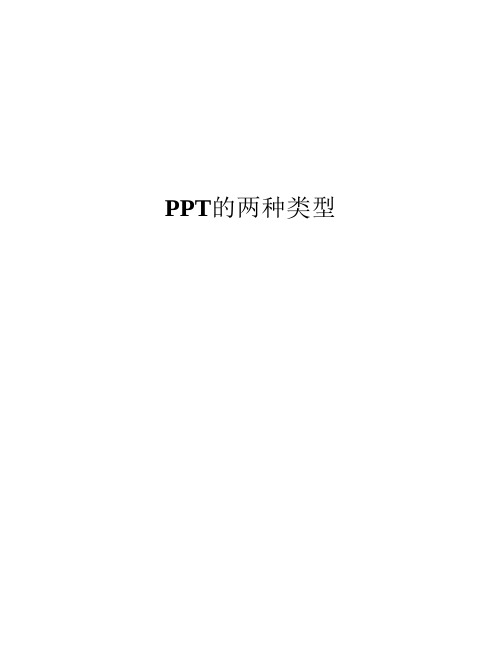
PPT的两种类型
在日常工作中,最常用到的PPT有两种类型,一种是要打印出来,像Word文档一样让人阅读的,我们称之为报告文档类PPT。
比如罗兰贝格的咨询报告。
另一种是要投影出来,帮助人讲解的,我们称之为演示辅助类PPT,比如学生用的答辩PPT。
由于用法不同,因此两类PPT制作要求有极大的区别。
1 罗兰贝格风格分析
罗兰贝格的PPT是报告文档类PPT的典范,仔细研究罗兰贝格的PPT,会给报告文档类PPT提供很有价值的参考,它的主要特点如下。
1 使用A4纸张大小的页面。
这是最适合打印的页面大小,能够充分利用纸张。
2 使用非常简单的模板(只在页面顶端拉一条很细的直线,报告内容均安排在此线以下),从而消除了任何干扰阅读的因素。
页面黑白,也可以使用一组深蓝作为配色,但绝不影响打印效果。
3 主要参考线将页面分为标题区、图表标题区以及主要图表区,如图1所示。
标题使用18号黑体,图表标题使用14号宋体。
主要图表区,正文使用10号宋体,小标题使用12号字体。
这种机械统一的模板有两个好处,一是在幻灯片边缘创造了空当,即使内容再多也不会感觉窒息;二是即便PPT是由多人合作完成,也能保持其风格统一。
图1 罗兰贝格PPT的页面划分。
罗兰贝格战略采购优化企业的采购管理
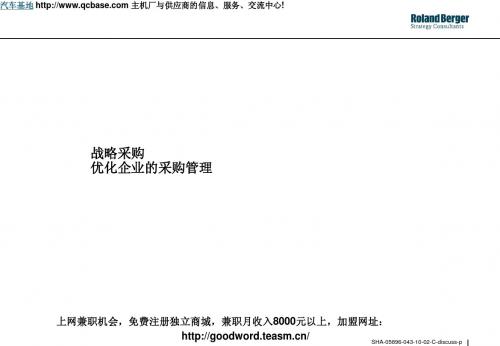
汽车基地 主机厂与供应商的信息、服务、交流中心!
战略采购 优化企业的采购管理
上网兼职机会,免费注册独立商城,兼职月收入8000元以上,加盟网址: / SHA-05896-043-10-02-C-discuss-p
战略采购还是一个帮助谈判的有效工具
谈判成功要素 • 谈判力度 • 谈判技巧 • 准备工作 – 对供应市场的了解 – 对采购类别的了解 – 对供应商的了解
这正是战略采购的方 法论所需要解决的问 题
上网兼职机会,免费注册独立商城,兼职月收入8000元以上,加盟网址: / SHA-05896-043-10-02-C-discuss-p
间接人工和 直接人工
外购的原材 服务和供应
6
汽车基地 主机厂与供应商的信息、服务、交流中心!
外购支出仅仅10%的减省就可对公司业绩产生巨大的财务影响
60%-80%
10%的外购 支出减省
6%-8%收益增长
谈判
竞标
总成本
经营成本
上网兼职机会,免费注册独立商城,兼职月收入8000元以上,加盟网址: / SHA-05896-043-10-02-C-discuss-p
1970
1980
1990
2000
改组 组织 • 大量裁员
工序重组 • 更多裁员
工序外包 • 更多裁员
具有高效率的 精简企业
上网兼职机会,免费注册独立商城,兼职月收入8000元以上,加盟网址: / SHA-05896-043-10-02-C-discuss-p
• • • • • •
邀请合资格的供应商 参与竞标 发出含有物品设计细 节的招标书 澄清有关招标书中的 问题 收集投标价格与方案 根据既定的标准选择 供应商 谈判
战略采购 优化企业的采购管理
上网兼职机会,免费注册独立商城,兼职月收入8000元以上,加盟网址: / SHA-05896-043-10-02-C-discuss-p
战略采购还是一个帮助谈判的有效工具
谈判成功要素 • 谈判力度 • 谈判技巧 • 准备工作 – 对供应市场的了解 – 对采购类别的了解 – 对供应商的了解
这正是战略采购的方 法论所需要解决的问 题
上网兼职机会,免费注册独立商城,兼职月收入8000元以上,加盟网址: / SHA-05896-043-10-02-C-discuss-p
间接人工和 直接人工
外购的原材 服务和供应
6
汽车基地 主机厂与供应商的信息、服务、交流中心!
外购支出仅仅10%的减省就可对公司业绩产生巨大的财务影响
60%-80%
10%的外购 支出减省
6%-8%收益增长
谈判
竞标
总成本
经营成本
上网兼职机会,免费注册独立商城,兼职月收入8000元以上,加盟网址: / SHA-05896-043-10-02-C-discuss-p
1970
1980
1990
2000
改组 组织 • 大量裁员
工序重组 • 更多裁员
工序外包 • 更多裁员
具有高效率的 精简企业
上网兼职机会,免费注册独立商城,兼职月收入8000元以上,加盟网址: / SHA-05896-043-10-02-C-discuss-p
• • • • • •
邀请合资格的供应商 参与竞标 发出含有物品设计细 节的招标书 澄清有关招标书中的 问题 收集投标价格与方案 根据既定的标准选择 供应商 谈判
内部培训-罗兰贝格整合营销

的了解
品牌资产决定
运用各种可能 的手段(品牌资产的 跟踪调查,资产能力 分析,概念图,需求/差异分析
整体资产与区域性/ 地方性差异的适当平衡
(如果需要的话)
精品课件 10
尽管在不同的行业/产品领域,品牌的感性价值在品牌总体价值中所处的 地位有所不同,但从各行业发展的趋势来看,品牌的感性价值的正变得 日趋重要
怎样
依靠制造营销奇迹来获得和维持目标顾客群体,可以通过价值定位和营 销计划两个方面来实现
价值定位
• 最佳总体解决方案
营销计划
• 在消费者最易于接受的时间和地点去打动他们 • 用合理的计划进行配合
精品课件 23
怎样
价值定位是依据满足消费者需要的各种原则制定出来的最佳价值方案
确保你依据的基本原则 是正确的
牢固的
品牌资产“审核” • 正确的选择 • 良好的表达
需要改进的 重新定义资产
转化为适当的传播战略
精品课件 17
举例
最后制定品牌传播策略,以保证在日常广告推介等活动中能以有效方式 持续一致地向客户传递品牌价值
举例:某国内领先的日常消费品品牌的传播策略
总体品牌资产 品牌价值 传播方式
理由支持 品牌个性
5 视觉识别:
对品牌的独特、长期一致的视觉表达
客户在所有接触点能立即识别,并与品牌相联系
往往需要一个有颜色表达的附件
6 目标客户描述:
对主要目标客户群的一个简短的描述,包括规模、背景,心理等信息
精品课件 3
什么
总体资产1) 的定义必须是容易让人理解和接受的
它是一个激发灵感的、朗朗上口 的、容易让人记住的概念,能够 表达你希望你的品牌怎样满足目 标顾客群体的需要,而不是为了 对付竞争者而进行的战术性考虑
品牌资产决定
运用各种可能 的手段(品牌资产的 跟踪调查,资产能力 分析,概念图,需求/差异分析
整体资产与区域性/ 地方性差异的适当平衡
(如果需要的话)
精品课件 10
尽管在不同的行业/产品领域,品牌的感性价值在品牌总体价值中所处的 地位有所不同,但从各行业发展的趋势来看,品牌的感性价值的正变得 日趋重要
怎样
依靠制造营销奇迹来获得和维持目标顾客群体,可以通过价值定位和营 销计划两个方面来实现
价值定位
• 最佳总体解决方案
营销计划
• 在消费者最易于接受的时间和地点去打动他们 • 用合理的计划进行配合
精品课件 23
怎样
价值定位是依据满足消费者需要的各种原则制定出来的最佳价值方案
确保你依据的基本原则 是正确的
牢固的
品牌资产“审核” • 正确的选择 • 良好的表达
需要改进的 重新定义资产
转化为适当的传播战略
精品课件 17
举例
最后制定品牌传播策略,以保证在日常广告推介等活动中能以有效方式 持续一致地向客户传递品牌价值
举例:某国内领先的日常消费品品牌的传播策略
总体品牌资产 品牌价值 传播方式
理由支持 品牌个性
5 视觉识别:
对品牌的独特、长期一致的视觉表达
客户在所有接触点能立即识别,并与品牌相联系
往往需要一个有颜色表达的附件
6 目标客户描述:
对主要目标客户群的一个简短的描述,包括规模、背景,心理等信息
精品课件 3
什么
总体资产1) 的定义必须是容易让人理解和接受的
它是一个激发灵感的、朗朗上口 的、容易让人记住的概念,能够 表达你希望你的品牌怎样满足目 标顾客群体的需要,而不是为了 对付竞争者而进行的战术性考虑
罗兰贝格的培训例案某地产发展战略

公司成立时间
某地产公司成立于XXXX年,是一 家专注于房地产开发的企业。
公司规模
经过多年的发展,某地产公司已经 拥有了一支高素质、经验丰富的团 队,员工数量达到XXX人。
公司业务范围
某地产公司的业务范围涵盖了房地 产开发、销售、物业管理等多个领 域,形成了完整的产业链。
某地产公司发展战略
01
02
03
利共赢。
地产行业竞争格局
地产行业竞争激烈,企业数量 众多,市场集中度逐渐提高。
品牌、资金和人才成为企业竞 争的核心要素,拥有品牌、资 金和人才优势的企业将更具竞 争力。
跨界竞争逐渐加剧,其他产业 的企业也纷纷涉足地产领域, 对传统地产企业构成一定威胁 。
03
某地产公司发展战略分析
某地产公司概况
共同探索新业务领域
在未来的发展中,双方将共同探索新的业务领域和商业模式,共同 开拓市场,实现更大的商业价值。
THANKS
THANK YOU FOR YOUR WATCHING
政策环境对地产行业影响较大,调控 政策不断出台,对行业发展产生一定 影响。
地产行业发展趋势
绿色建筑和可持续发展成为行业 发展趋势,未来将有更多企业加
入绿色建筑领域。
智能化和数字化技术将广泛应用 于地产行业,提高开发效率和运
营效率。
多元化和跨界合作成为行业发展 的新趋势,地产企业将与其他产 业进行合作,实现资源共享和互
市场定位
某地产公司以中高端房地 产市场为主要定位,注重 产品的品质和设计,以满 足客户的需求。
土地储备战略
某地产公司注重土地储备 ,通过多种渠道获取优质 土地资源,为公司的持续 发展提供保障。
合作与联盟
某地产公司积极寻求与其 他房地产企业、金融机构 等的合作与联盟,共同开 发项目,实现互利共赢。
某地产公司成立于XXXX年,是一 家专注于房地产开发的企业。
公司规模
经过多年的发展,某地产公司已经 拥有了一支高素质、经验丰富的团 队,员工数量达到XXX人。
公司业务范围
某地产公司的业务范围涵盖了房地 产开发、销售、物业管理等多个领 域,形成了完整的产业链。
某地产公司发展战略
01
02
03
利共赢。
地产行业竞争格局
地产行业竞争激烈,企业数量 众多,市场集中度逐渐提高。
品牌、资金和人才成为企业竞 争的核心要素,拥有品牌、资 金和人才优势的企业将更具竞 争力。
跨界竞争逐渐加剧,其他产业 的企业也纷纷涉足地产领域, 对传统地产企业构成一定威胁 。
03
某地产公司发展战略分析
某地产公司概况
共同探索新业务领域
在未来的发展中,双方将共同探索新的业务领域和商业模式,共同 开拓市场,实现更大的商业价值。
THANKS
THANK YOU FOR YOUR WATCHING
政策环境对地产行业影响较大,调控 政策不断出台,对行业发展产生一定 影响。
地产行业发展趋势
绿色建筑和可持续发展成为行业 发展趋势,未来将有更多企业加
入绿色建筑领域。
智能化和数字化技术将广泛应用 于地产行业,提高开发效率和运
营效率。
多元化和跨界合作成为行业发展 的新趋势,地产企业将与其他产 业进行合作,实现资源共享和互
市场定位
某地产公司以中高端房地 产市场为主要定位,注重 产品的品质和设计,以满 足客户的需求。
土地储备战略
某地产公司注重土地储备 ,通过多种渠道获取优质 土地资源,为公司的持续 发展提供保障。
合作与联盟
某地产公司积极寻求与其 他房地产企业、金融机构 等的合作与联盟,共同开 发项目,实现互利共赢。
罗兰贝格国内外产业园案例(经典)课件

产业园特点
产业园通常具备产业集聚、政策优惠、服务配套、创新驱动等特征,是区域经 济发展的重要载体和引擎。
产业园发展历程
产业园起源
发展趋势
产业园的概念起源于欧美国家,最初 是为了应对工业革命带来的产业集聚 和城市化问题而设立。
未来产业园将更加注重创新、绿色、 智慧化发展,推动产业转型升级和高 质量发展。
英国剑桥产业园
总结词
世界级科技研发中心
详细描述
英国剑桥产业园以剑桥大学为中心,拥有世界级的科技研发实力和创新能力,特别是在生物医药、新 材料和新能源等领域取得了显著成果。剑桥产业园的成功得益于其与大学、研究机构和企业的紧密合 作,以及政府对创新的大力支持。
德国慕尼黑产业园
总结词
欧洲领先的科技产业集群
总结词ቤተ መጻሕፍቲ ባይዱ
产学研一体化
详细描述
北京中关村产业园注重产学研一体化发展,通过高校和 科研机构的合作,推动科技成果的转化和应用,提升产 业整体竞争力。
上海张江产业园
总结词
国际化特色
详细描述
上海张江产业园致力于打造具有国际影响力的科技创新园 区,吸引外资和国际企业入驻,推动产业国际合作和交流 。
总结词
高端产业集聚
产业链完善
详细描述
深圳高新技术产业园采用企业主导的发展 模式,充分发挥市场机制的作用,推动企 业自主创新和技术进步。
详细描述
深圳高新技术产业园注重完善产业链条, 推动上下游企业协同发展,形成产业集聚 效应,提升整体竞争力。
04
罗兰贝格经典案例分析
案例一:某高科技产业园规划
总结词
成功打造产业集群
详细描述
产业园比较
不同类型产业园之间存在竞争与合 作,各地区应根据自身条件和发展 需求选择合适的产业园类型,实现 产业升级和发展。
产业园通常具备产业集聚、政策优惠、服务配套、创新驱动等特征,是区域经 济发展的重要载体和引擎。
产业园发展历程
产业园起源
发展趋势
产业园的概念起源于欧美国家,最初 是为了应对工业革命带来的产业集聚 和城市化问题而设立。
未来产业园将更加注重创新、绿色、 智慧化发展,推动产业转型升级和高 质量发展。
英国剑桥产业园
总结词
世界级科技研发中心
详细描述
英国剑桥产业园以剑桥大学为中心,拥有世界级的科技研发实力和创新能力,特别是在生物医药、新 材料和新能源等领域取得了显著成果。剑桥产业园的成功得益于其与大学、研究机构和企业的紧密合 作,以及政府对创新的大力支持。
德国慕尼黑产业园
总结词
欧洲领先的科技产业集群
总结词ቤተ መጻሕፍቲ ባይዱ
产学研一体化
详细描述
北京中关村产业园注重产学研一体化发展,通过高校和 科研机构的合作,推动科技成果的转化和应用,提升产 业整体竞争力。
上海张江产业园
总结词
国际化特色
详细描述
上海张江产业园致力于打造具有国际影响力的科技创新园 区,吸引外资和国际企业入驻,推动产业国际合作和交流 。
总结词
高端产业集聚
产业链完善
详细描述
深圳高新技术产业园采用企业主导的发展 模式,充分发挥市场机制的作用,推动企 业自主创新和技术进步。
详细描述
深圳高新技术产业园注重完善产业链条, 推动上下游企业协同发展,形成产业集聚 效应,提升整体竞争力。
04
罗兰贝格经典案例分析
案例一:某高科技产业园规划
总结词
成功打造产业集群
详细描述
产业园比较
不同类型产业园之间存在竞争与合 作,各地区应根据自身条件和发展 需求选择合适的产业园类型,实现 产业升级和发展。
PPT素材——逻辑框架(PPT模板)全

品牌价值内涵--功能层面
品牌价值外延
品牌价值内涵--情感层面
历史传承
可感知的价值
可感知的质量
功能利益
人格特征
社会特征
个人联系度
品牌名称、标志、广告语
健康高认知品牌
推荐率
购买性
美誉度
认知度
使用率
传播缺乏品牌
推荐率
购买性
美誉度
认知度
使用率
健康低认知品牌
推荐率
购买度
美誉度
认知度
使用率
虚名品牌
推荐率
购买性
美誉度
发展战略:积极扩大经济规模和市场机会,以长远利益为目标,提高市场占有率,加强竞争地位
明星产品
问题产品
现金牛产品
瘦狗产品
发展战略:不必再增大投资,成为企业回收资金,支持其它产品,尤其明星产品投资的后盾
发展战略:选择性投资战略,重点扶持将来有希望成为明星的产品,其它产品则采取观望政策
发展战略:撤退战略,减少批量,逐渐撤退,淘汰部分产品,将剩余资源向其它产品转移
软件因素
企业价值观;企业风格;人才能力
Structure(组织结构)
Strategy(战略)
Style(企业风格)
Shared Value(企业价值观)
System(组织制度)
Skill(组织能力)
Staff(人才)
11/20/2020
8
让价值被看见 | 国内领先的商业演示咨询与设计机构
五力模型—五方力量的综合分析
麦肯锡7s分析法
指出了企业在发展过程中必须全面地考虑各方面的情况,包括结构、制度、风格、员工、技能、战略、共同价值观,也就是说,企业仅具有明确的战略是远远不够的,还需要考虑其它因素。在企业管理中,综合考虑公司的软硬件资源,在管理咨询中经常用此模型对企业管理中的短板进行诊断;
品牌价值外延
品牌价值内涵--情感层面
历史传承
可感知的价值
可感知的质量
功能利益
人格特征
社会特征
个人联系度
品牌名称、标志、广告语
健康高认知品牌
推荐率
购买性
美誉度
认知度
使用率
传播缺乏品牌
推荐率
购买性
美誉度
认知度
使用率
健康低认知品牌
推荐率
购买度
美誉度
认知度
使用率
虚名品牌
推荐率
购买性
美誉度
发展战略:积极扩大经济规模和市场机会,以长远利益为目标,提高市场占有率,加强竞争地位
明星产品
问题产品
现金牛产品
瘦狗产品
发展战略:不必再增大投资,成为企业回收资金,支持其它产品,尤其明星产品投资的后盾
发展战略:选择性投资战略,重点扶持将来有希望成为明星的产品,其它产品则采取观望政策
发展战略:撤退战略,减少批量,逐渐撤退,淘汰部分产品,将剩余资源向其它产品转移
软件因素
企业价值观;企业风格;人才能力
Structure(组织结构)
Strategy(战略)
Style(企业风格)
Shared Value(企业价值观)
System(组织制度)
Skill(组织能力)
Staff(人才)
11/20/2020
8
让价值被看见 | 国内领先的商业演示咨询与设计机构
五力模型—五方力量的综合分析
麦肯锡7s分析法
指出了企业在发展过程中必须全面地考虑各方面的情况,包括结构、制度、风格、员工、技能、战略、共同价值观,也就是说,企业仅具有明确的战略是远远不够的,还需要考虑其它因素。在企业管理中,综合考虑公司的软硬件资源,在管理咨询中经常用此模型对企业管理中的短板进行诊断;
罗兰贝格-PPT制作工具2012
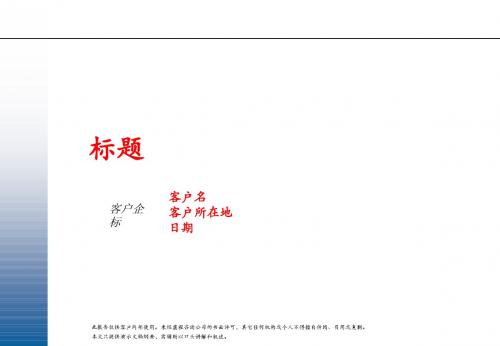
行间距也是预设的,不要按两次回车以增加行间距
记住,复制是最有效而准确的方式将一个对象的格式应用到另一个上。所以如果 你要插入一个新的对象如文本框,并且对格式不那么确定,请从工具文档中复制
Doc. number to be entered by "Header and Footer"
3
使用指引
Graph Title
Label 7
501
Label 6
432
Label 5
238
Label 4
189
Label 3
167
Label 2
130
Label 1
124
Doc. number to be entered by "Header and Footer"
18
Chances/risks
• …
…
• …
按住鼠标左键拖动覆盖住你想选择的多个对象,你能选中拖动区域内所有的对象 。结合Shift键可以十分方便地选中一些小的或隐藏的对象
快捷键 Ctrl-A 可使你选中幻灯片中所有的对象或者文本框中所有的文本 按住 shift 击中文本框的任一部分,你便能选中整个文本框 在文本框中,按击鼠标左键三次可选中整个段落;两次选中词或词组。
Font Size Font Pick up and apply format Rotate tools Group and ungroup Color tools Indent tools Bullets Ruler
Most Frequently Used Shapes New Text Box Line Formatting Tools Shadow Tools
罗兰贝格咨询PPT模板
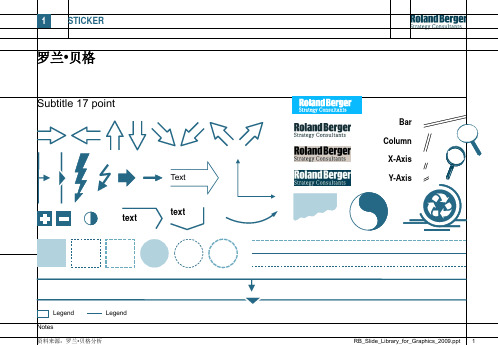
17 point text: Level 0
RB_Slide_Library_for_Graphics_2009.ppt
15
Consequences 2
13 point text: Level 0
• Level 1 – Level 2 13 point text: Level 0 • Level 1 – Level 2 13 point text: Level 0 • Level 1 – Level 2 13 point text: Level 0 • Level 1 – Level 2
13 point text • Level 1 – Level 2 - Level 3
RB_Slide_Library_for_Graphics_2009.ppt
20
Process/Phases 3
13 point text • Level 1 – Level 2 - Level 3
13 point text • Level 1 – Level 2 - Level 3
13 point text • Level 1 – Level 2 - Level 3
13 point text • Level 1 – Level 2 - Level 3
13 point text • Level 1 – Level 2 - Level 3
RB_Slide_Library_for_Graphics_2009.ppt
13 point text • Level 1 – Level 2 - Level 3
RB_Slide_Library_for_Graphics_2009.ppt
17
Consequences 4
13 point text • Level 1 – Level 2 - Level 3
罗兰贝格_销售新思路,SALES UP
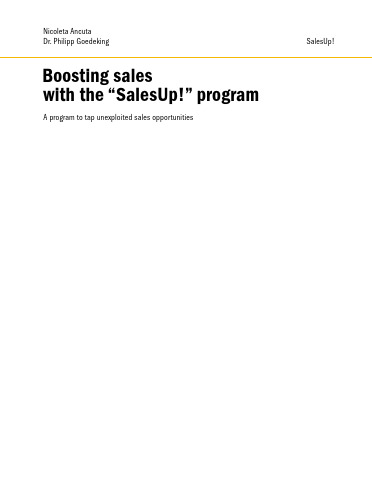
Nicoleta Ancuta Dr. Philipp Goedeking
SalesUp!
Boosting sales with the “SalesUp!” program
A program to tap unexploited sales opportunities
2
|
3
|
SalesUp!
What “SalesUp!” can achieve
4
|
5
|
SalesUp!
1. Focus: Focusing the right sales measures on the sales channels, accounts, products and markets with the highest potential for growth. 2. Push: Mobilizing and concentrating all resources specifically on these key market segments. In a large number of sales projects in a variety of industries and on all continents, both these levers have proved to be key. Other factors may also be relevant, but they are far less important than Focus and Push. “SalesUp!” produces incredible results: At a European airline with a worldwide network, it brought about a sales increase of 20 to 30 percent in some national sales markets. One of the largest French trading firms used “SalesUp!” and raised sales to its newly defined “A” customers by 40 percent, as did a European media company and a Chinese consumer goods distributor. If these levers are so effective, why then do so many sales organizations continue to work in an unfocused way and with diffuse, and therefore too little, sales pressure? Why do they leave untapped so much of the market that they are “entitled to” through sloppy sales practices [Figure 2]? Our experience shows that the reasons for this are similar in all cases: 1. Lack of focus: Market segmentations that may have been correct in the past, are retained by sales managers as supposedly being “proven”, and are never reviewed. At one international trading firm, we were even confronted with a segmentation dating from 1995 – which did not particularly bother the management. Customers who were ranked as “A” in the past will probably still be “A” today. Those who were ranked “C” in the past don't merit any attention today either. Only rarely can the sales division state precisely which products should be sold to which customers using which sales channels. 2. Insufficient sales pressure: Salespeople prefer to spend their time with “nice” customers, i.e. those with whom they have always done good business, where everything runs smoothly, where the market share is pleasing, and which justifies a nice meal with fine wine every once in a while. Salespeople typically dislike spending time with those customers “who won't buy anything anyway”, those who do spend a lot, but unfortunately with other suppliers. The sales staff overlooks the fact that their favorite customers offer few opportunities to increase sales volumes, in contrast to the supposedly difficult customers.
SalesUp!
Boosting sales with the “SalesUp!” program
A program to tap unexploited sales opportunities
2
|
3
|
SalesUp!
What “SalesUp!” can achieve
4
|
5
|
SalesUp!
1. Focus: Focusing the right sales measures on the sales channels, accounts, products and markets with the highest potential for growth. 2. Push: Mobilizing and concentrating all resources specifically on these key market segments. In a large number of sales projects in a variety of industries and on all continents, both these levers have proved to be key. Other factors may also be relevant, but they are far less important than Focus and Push. “SalesUp!” produces incredible results: At a European airline with a worldwide network, it brought about a sales increase of 20 to 30 percent in some national sales markets. One of the largest French trading firms used “SalesUp!” and raised sales to its newly defined “A” customers by 40 percent, as did a European media company and a Chinese consumer goods distributor. If these levers are so effective, why then do so many sales organizations continue to work in an unfocused way and with diffuse, and therefore too little, sales pressure? Why do they leave untapped so much of the market that they are “entitled to” through sloppy sales practices [Figure 2]? Our experience shows that the reasons for this are similar in all cases: 1. Lack of focus: Market segmentations that may have been correct in the past, are retained by sales managers as supposedly being “proven”, and are never reviewed. At one international trading firm, we were even confronted with a segmentation dating from 1995 – which did not particularly bother the management. Customers who were ranked as “A” in the past will probably still be “A” today. Those who were ranked “C” in the past don't merit any attention today either. Only rarely can the sales division state precisely which products should be sold to which customers using which sales channels. 2. Insufficient sales pressure: Salespeople prefer to spend their time with “nice” customers, i.e. those with whom they have always done good business, where everything runs smoothly, where the market share is pleasing, and which justifies a nice meal with fine wine every once in a while. Salespeople typically dislike spending time with those customers “who won't buy anything anyway”, those who do spend a lot, but unfortunately with other suppliers. The sales staff overlooks the fact that their favorite customers offer few opportunities to increase sales volumes, in contrast to the supposedly difficult customers.
PPT经典模板(蓝色调)

艺术字
艺术字字体创意、独特,适合创意、时尚类PPT,如广告、设计类 主题。
书法体
书法体字体古朴、典雅,适合中国风、文化类PPT,如传统文化、诗 词类主题。
感谢您的观看
THANKS
标题位置
标题应居中放置,保持与 幻灯片边缘的适当距离, 以突出主题。
副标题设计
副标题字体
副标题的字体应与标题相协调, 可以选择微软雅黑或黑体的变种。
副标题内容
副标题应简洁明了,概括性地解释 主题内容,帮助观众理解幻灯片的 主题。
副标题位置
副标题可以放置在标题下方或幻灯 片左侧,根据实际需要选择合适的 位置。
标题字体推荐
微软雅黑粗体
微软雅黑粗体字体粗犷有力,适合标题或重点内容的强调。
方正兰亭特黑
方正兰亭特黑字体大气、稳重,适合高端、专业的PPT标题。
汉仪旗黑
汉仪旗黑字体简洁、现代,适合现代风格的PPT标题。
其他字体应用场景
手写体
手写体字体亲切、自然,适合温馨、感性的PPT内容,如亲子、情 感类主题。
总结内容
对听众表示感谢,对本次演讲或展示进行简短总结。
风格
简洁明了,表达出感激之情,同时展现专业素养。
示例
“感谢各位的聆听,本次展示到此结束,如有疑问,请随时与我们 联系。”
公司logo插入
1 2
位置
PPT最后一页,通常位于左上角或右上角。
尺寸
根据PPT页面大小和比例,合理调整logo的大小, 保持清晰可见。
绿色
用于表示成功、健康或积极的信息, 增加PPT的亲和力。
06 字体选择
正文字体推荐
微软雅黑
01
微软雅黑字体清晰易读,适合长时间阅读,是制作PPT的首选字
艺术字字体创意、独特,适合创意、时尚类PPT,如广告、设计类 主题。
书法体
书法体字体古朴、典雅,适合中国风、文化类PPT,如传统文化、诗 词类主题。
感谢您的观看
THANKS
标题位置
标题应居中放置,保持与 幻灯片边缘的适当距离, 以突出主题。
副标题设计
副标题字体
副标题的字体应与标题相协调, 可以选择微软雅黑或黑体的变种。
副标题内容
副标题应简洁明了,概括性地解释 主题内容,帮助观众理解幻灯片的 主题。
副标题位置
副标题可以放置在标题下方或幻灯 片左侧,根据实际需要选择合适的 位置。
标题字体推荐
微软雅黑粗体
微软雅黑粗体字体粗犷有力,适合标题或重点内容的强调。
方正兰亭特黑
方正兰亭特黑字体大气、稳重,适合高端、专业的PPT标题。
汉仪旗黑
汉仪旗黑字体简洁、现代,适合现代风格的PPT标题。
其他字体应用场景
手写体
手写体字体亲切、自然,适合温馨、感性的PPT内容,如亲子、情 感类主题。
总结内容
对听众表示感谢,对本次演讲或展示进行简短总结。
风格
简洁明了,表达出感激之情,同时展现专业素养。
示例
“感谢各位的聆听,本次展示到此结束,如有疑问,请随时与我们 联系。”
公司logo插入
1 2
位置
PPT最后一页,通常位于左上角或右上角。
尺寸
根据PPT页面大小和比例,合理调整logo的大小, 保持清晰可见。
绿色
用于表示成功、健康或积极的信息, 增加PPT的亲和力。
06 字体选择
正文字体推荐
微软雅黑
01
微软雅黑字体清晰易读,适合长时间阅读,是制作PPT的首选字
- 1、下载文档前请自行甄别文档内容的完整性,平台不提供额外的编辑、内容补充、找答案等附加服务。
- 2、"仅部分预览"的文档,不可在线预览部分如存在完整性等问题,可反馈申请退款(可完整预览的文档不适用该条件!)。
- 3、如文档侵犯您的权益,请联系客服反馈,我们会尽快为您处理(人工客服工作时间:9:00-18:30)。
• …
…
• …
…
• …
3
4
…
• …
.... ....
…
• …
.... ....
…
• …
....
Module und Variations_E
9
Schedule
1 2
Activities A.
1
Month 1 2 3
4
5
6
Month 2 7
8
9
10
Month 3 11 12
Activities A.
35
49 67 73
Module und Variations_E
2
A.
Standard slides
Module und Variations_E
3
Consultant profile: [first name, last name]
Position: xxxxxxxxxxxxxxxxxxxxxxxx Education
1 2
Opportunities
• …
Threats
• …
• …
Threats
• …
Opportunities 3 4
Opportunities
• …
Threats
• … • …
Opportunities
• …
Threats
Module und Variations_E
26
Special types of matrix – pros and cons
4
Guidelines 4
Comments 4
5
Guidelines 5 Comments 5
Module und Variations_E
11
Module und Variations_E
12
C.
Lists (2) – Factors, specific number
Module und Variations_E
....
...
... ... ...
...
... ... ...
...
... … ... … ... … ... … ... … ... … ... ... ... ... ... ... ... ... ... ... ... ... ... ... ...
...
... … ... … ... … ... … ... … ... … ... ... ... ... ... ... ... ... ... ... ... ... ... ... ...
Module und Variations_E
47
Various types of brackets (to be used instead of block arrows)
3 7 13 24
E. Process (1) – Factors, steps
F. Process (2) – Factors, impact G. Process (3) – Factors, interlinked Annex: Nine key changes compared to the old standards
7
Lists – horizontal (variations)
1 2
Heading
• Details
Heading
• Details
Heading
• Details
Heading
• Details
Heading
• Details
Heading
• Details
3
4
Heading
• Details
1 2
3
4
Module und Variations_E
44
Nodes/interfaces
1
4
5
2
6
7
3
8
9
Module und Variations_E
45
Pressure
1 2
Module und Variations_E
46
Increase/decrease
1 2 3 4 5 6 7 8
...
... … ... … ... … ... … ... … ... … ... ... ... ... ... ... ... ... ... ... ... ... ... ... ...
...
... … ... … ... … ... … ... … ... … ... ... ... ... ... ... ... ... ... ... ... ... ... ... ...
• ...
BOTTOM UP
TOP DOWN
Module und Variations_E
31
Special types of matrix – bottom up/top down (2)
1
TOP
• ... • ...
DOWN
BOTTOM
2
UP
Module und Variations_E
32
Special types of matrix – equilibrium
…
... ... ...
…
... ... ...
…
... ... ...
…
... ... ...
…
... ... ...
…
... ... ...
Module und Variations_E
6
B.
Lists (1) – Factors, no specific number
Module und Variations_E
Factor 1
2 1
Factor 2
Four dynamic factors
3
Factor 4
4
Factor 3
Module und Variations_E
22
6 factors (variation)
Module und Variations_E
23
D.
Matrix – Factors, comparisons
40
Hurdles
Module und Variations_E
41
Resistance/obstacles
1 2 3 4
5
6
7
Module und Variations_E
42
Filters
1 2 3
5 4
6
Module und Variations_E
43
Change of mindset/direction
1
2
3
Module und Variations_E
36
Process/phases
1
1 … 2 … 3 … 4 … 5 …
2
Phase 1
Phase 2
Phase 3
•
…
•
…
•
…
3
Phase 1 Phase 2 Phase 3
4
Phase 1 Phase 2 Phase 3
• …
• …
• …
• …
• xxxxxxxxxxxxxxxxxxxxxxxxxxxxxxxxxxxxx
Industry competence
• xxxxxxxxxxxxxxxxxxxxxxxxxxxxxxxxxxxx
Languages
• German • xxxxxxxxxxxxxxxxxxxxxxxxxxxxxxxxxxxx
...
... … ... … ... … ... … ... … ... … ... ... ... ... ... ... ... ... ... ... ... ... ... ... ...
...
... … ... … ... … ... … ... … ... … ... ... ... ... ... ... ... ... ... ... ... ... ... ... ...
4
Factor 2
Factor 3
3
Module und Variations_E
20
4 factors (3a – weighted)
Factor 1
2
Factor 4
4
Factor 2
Factor 3
3
Module und Variations_E
21
4 factors (3b – dynamic)
• …
• …
Module und Variations_E
37
Cycles (1) (color presentation)
Module und Variations_E
38
Cycles (2)
Module und Variations_E
39
Spirals (orthogonal)
1 2
Module und Variations_E
xxxx-xxxx xxxxxxxxxxxxxxxxxxxxxxxxxxx
Born: xxxx Professional experience
xxxx-xxxx xxxxxxxxxxxxxxxxxxxxxxxxxxx
Nationality: xxxxxxxxxxxxxxxxxxxxx Key projects
Updated: mm/year
Methodological competence
